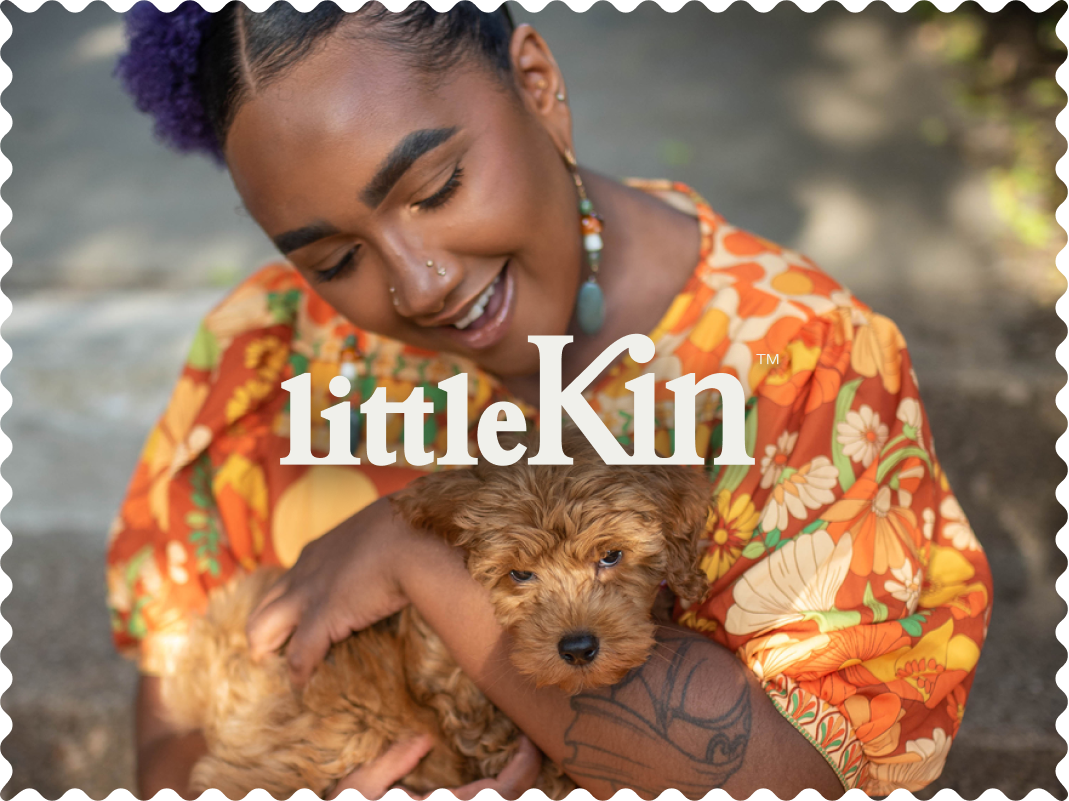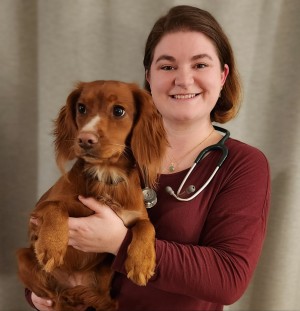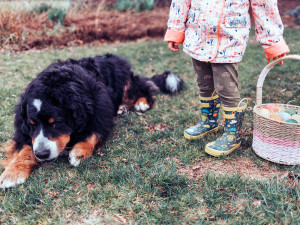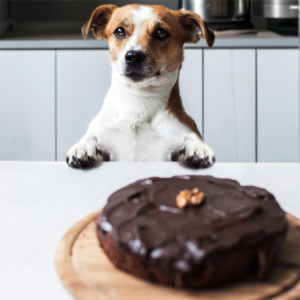Easter Emergency: What to Do if Your Dog Eats Chocolate Easter Eggs
Chocolate isn’t fun for everyone

Share Article
In this article:
Emergency actionsopens in a new tab Why chocolate is bad for dogsopens in a new tab Chocolate types and toxicity levelsopens in a new tab Dog size and toxicityopens in a new tab Prevention tipsopens in a new tab Emergency resourcesopens in a new tab
It’s finally spring, so fingers crossed you’re enjoying all the nice bits that come with it, including indulging in all our favourite chocolatey treats. But, what happens if you come home to find your stash of Easter eggs has been raided by your otherwise perfect pup? Firstly, don’t panic. Read on to find out what to do if this emergency situation occurs so you can be best prepared to get your pup the medical attention they need.

littleKin™ is Kinship’s home just for puppy and kitten parents. Bop over to check out expert advice, new pet tools, and special deals—all curated for your newest family member.
opens in a new tabImmediate action steps
If you suspect your dog has eaten chocolate, take the following steps:
Call your vet immediately
Having your vet practice’s number close to hand is useful in these situations. Try to keep it saved on your mobile, or written down in an obvious place near a phone, or even engraved on your pet’s tag. The sooner you speak to your vet, the better, as your vet can only induce emesis (make them vomit) within two hours of ingestion.
Note the type/amount of chocolate and dog’s weight
Your vets will ask what your dog has eaten; the type of chocolate, amount consumed, your dog’s weight and how long ago they ate it. Try to have these bits of info ready. Finding the wrapper and ingredients with the weight shown on the packet is really helpful!
Watch for symptoms
Symptoms can range from mild to severe, depending on the amount and type of chocolate eaten. Look out for signs of vomiting, diarrhoea, fast breathing, restlessness or seeming wobbly. At high doses, tremors, seizures and death can occur.
Do not try to induce vomiting at home unless directed to by your vet; this can be very dangerous unless under vet supervision and can make the situation worse due to the risk of aspiration.
Why chocolate is dangerous for dogs
Theobromine toxicity in dogs
So, why is chocolate ok for us and not our dogs? The ingredients that are dangerous are the theobromine and caffeine within the chocolate. Theobromine is a stimulant found in cocoa beans which has a similar effect to caffeine. Human bodies can tolerate the effects, but theobromine is metabolised much slower in dogs, and so it causes a build-up of the stimulant in their body which affects the central nervous systemopens in a new tab, cardiovascular and respiratory systems.
Different chocolate types and their toxicity levels (dark is most dangerous)
Different types of chocolate contain different amounts of theobromine and caffeine. The darker and more bitter tasting the chocolate, generally the more theobromine per gram. So, the most dangerous type of chocolate is cocoa powder and dark chocolate. The lethal toxic dose of theobromine and caffeine is between 100–500 mg/kg for dogs, and dark chocolate can contain 20mg per gram. Therefore, an average Easter egg of 100g could be a lethal risk to a 10kg dog if made of dark chocolate.
If all this is sounding too much like GCSE maths at a time when you’re panicking about your dog, try this chocolate toxicity calculatoropens in a new tab to help you determine the risk.
Smaller dogs are at a higher risk
As chocolate toxicity in dogs is dose-dependent on weight, the size of your dog is a vital piece of information for a vet treating your dog. Smaller dogs are at more risk of toxicity as the amount of chocolate eaten per kilogram of body weight is more compared to a larger dog if they eat the same amount. Your vet will be able to calculate the risk of toxicity based on your dog’s weight and the amount and type of chocolate consumed. Take the same example above of a 100g dark chocolate Easter egg; this is a potentially lethal dose for a 10kg dog but is of lower risk to a 40kg dog. They may just experience milder symptoms such as vomiting and diarrhoea.
Prevention tips
Safe Easter egg storage
Keep Easter eggs safely stored away from pets, ideally in an air-tight container to limit the enticing smells that might tempt your dog. If keeping your chocolate in a cupboard, make sure it is above the height a dog can reach – they are very capable of nosing a door open! Make sure every member of the family understands the risk, and that they must not leave Easter eggs unsupervised while enjoying them.
Dog-friendly Easter treat alternatives
Everyone enjoys a treat for Easter, and there are many alternatives to chocolate Easter eggs for dogs to enjoy. Some non-chocolate Easter eggs are produced just for dogsopens in a new tab, but make sure it’s dog-safe before giving it to your pet. Take care when giving your dog new treats, as they can experience allergies or risk an upset stomach from changes to their diet. One way to enjoy the holiday with your pet is to hide their normal favourite treats around the house or garden and give them an Easter egg-less huntopens in a new tab made just for them!
Training commands for ‘leave it’
If you catch your pup red handed (pawed?) stealing your Easter egg, it would be great to be able to say ‘leave it’ and for them to stop. Start that training before you need it! Begin by using a high-value treat to get them to drop what they’re holding during training sessions, and try not to rush towards them to take what they have while training, as it may turn into a chasing game.
UK-specific resources
Emergency vet services open during Easter bank holidays
All vet practices in the UK have an under care regulationopens in a new tab, meaning that there is always an emergency service available to use out-of-hours by your vets or at another practice on their behalf. Even if your regular vets are closed over the Easter weekend, they will have a partner or nearby practice they are linked with who provide cover for their patients. Call the normal number for your vet practice, even if they are closed, and they will direct you to the emergency service.
Animal Poison Line contact information
If your dog has eaten something and you are worried about toxicity, your regular vet and out-of-hours vet will have access to the Veterinary Poisons Information Service, which will have more information. Alternatively, you can call their owners’ hotline, the Animal PoisonLineopens in a new tab: +44 (0)1202 509000.
Resources
“ What Is the Requirement to Provide 24/7 In-Person Care?opens in a new tab” The Royal College of Veterinary Surgeons, 2025. Accessed 8 Apr. 2025.
Finlay, F., and Guiton, S.. “ Chocolate Poisoningopens in a new tab.” BMJ : British Medical Journal, vol. 331, no. 7517, Sept. 2005, p. 633. Accessed 8 Apr. 2025.
“ Animal PoisonLineopens in a new tab” Veterinary Poisons Information Service, 23 Aug. 2016. Accessed 9 Apr. 2025.

Dr Josephine Corrick, BVMSci, BSc, MRCVS
Dr Josephine Corrick, BVMSci, BSc, MRCVS is a veterinary surgeon based in the south of Scotland where she has been since graduating from the University of Surrey. She enjoys working in general practice treating small animals. Her particular interests include diagnostic imaging and the treatment of wildlife.
Having found a passion for veterinary medicine after doing a degree in Equine Sports Science she still enjoys including horses in her life by spending time with her highland ponies. Alongside her clinical work, she helps run a smallholding caring for rare breed sheep and exploring the Scottish countryside with her young Cocker Spaniel.

